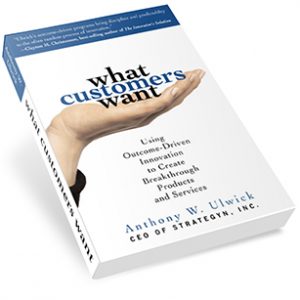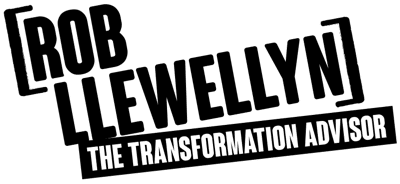
Outcome Driven Innovation is a strategy and innovation process built around the idea that people buy products and services to get jobs done. It does this by linking a company’s value creation activities to customer-defined metrics. The outcome of Outcome Driven Innovation is an 86 percent success rate at helping companies make product and marketing decisions that ensure the growth of core markets and the successful entry into adjacent and new markets.
While scattergun brainstorming is common in many firms, often it doesn’t work. But sequenced and focused idea generation does work, and the Outcome Driven Innovation process has been refined since before the turn of the century to provide a complete and unambiguous innovation language, along with the potential for companies to achieve at least a 70–90 percent success rate – all while reducing development costs and time to market.
The Focal Point of Innovation in Transformation
In an increasingly digital world, companies know they must innovate, digitise and transform, and that successful innovation is critical to their ability to survive and thrive in today’s rapidly changing markets. But too many firms are found to be digitising the past, skimping on innovation, and fooling themselves into believing they are transforming their business, and I coined the term “The Great Digital Illusion” to describe this phenomena.
While many firms claim to be innovative, only the minority adopt proven innovation processes that don't date back to the last century. While those that adopt the more proven up-to-date approaches create a new future for themselves, others sadly put so much into transformation efforts that are doomed from the outset and which contribute to the 70–90 % of new product failure rates that companies suffer these days. What's worse is that some companies even institutionalise these broken innovation processes, which leaves little hope for their longevity – despite what they achieved in the past.
In a recent McKinsey poll, 84% of global executives reported that innovation was extremely important to their growth strategies, but a staggering 94% were dissatisfied with their organizations’ innovation performance.
Before any company adopts and institutionalises an innovation programme, it must decide which innovation processes and practices to employ. It's a decision that will be fundamental to the company's ability to stay in business. In order to run a innovative digital transformation programme that produces meaningful outcomes and good return on investment, your innovation process needs to help you plan ahead and surface any potential bottlenecks quickly.
Customer Value Fulfils Specific Outcomes
Customer value must come from a firm's ability to fulfil a specific, relevant outcome in the customer’s work or life. Because when sophisticated customers have choice on an unprecedented scale, the primary motivation for buying something has now become a firm's ability to satisfy a want or need in the customer’s life. So it's vital firms stay mindful of this in their efforts to innovate, digitise and transform their business.
Today more than ever, companies are looking at innovation as the key to growth, and a way to march successfully into the Fourth Industrial Revolution – a place where no CEO had been until recent years. So CEOs have appointed VPs of Innovation, Chief Innovation Officers and set up innovation teams to take on the challenge of innovation. While doing their professional best, many of these efforts provide disappointing outcomes for the firm – because they missed the point of fulfilling specific outcomes for customers. They missed it because they overlooked the customers' jobs-to-be-done.
In his books and articles on innovation Clayton Christensen mentions the jobs-to-be-done theory, but Tony Ulwick turned theory into science by making the job the customer is trying to get done (not the customer or competition) the focal point of innovation.
What Customers Want
In What Customers Want Tony explains that the process of innovation is the set of steps that people and companies take to create products and services that customers value, that Outcome-Driven Innovation begins by understanding the customer’s jobs to be done, some of which are traditional (like writing a book) while others are emotional (like creating a reputation as a writer). He tells us that anytime we can help someone, or some group, accomplish its jobs faster, more conveniently, less expensively, we are creating customer value.

What Customers Want makes it clear that because companies are focused on customers and products (and not the job the customer is trying to get done), they are simply getting the wrong inputs into innovation, and incredibly, they don't know it.
Tony explains that to truly succeed at innovation, companies must understand just what a customer “need” is. And I will add to this by saying that when a company fails to succeed at innovation, their investment of time, money, hearts and mind in transformation has good odds of not being a success story the CEO needs it to be.
Some key points from the book include:
1. When it comes to innovation, the job, not the product, must be the unit of analysis.
2. A job map provides the structure needed to ensure all customer needs are captured.
3. When the job is the unit of analysis, needs take the form of customer-defined metrics.
4. Outcome Driven Innovation’s “jobs-to-be-done” principles apply equally well to design innovation.
5. The opportunity algorithm makes it possible to prioritise unmet needs.
6. Opportunities (unmet needs) dictate which growth strategy to pursue.
8. Concepts can be evaluated with precision against customer-defined metrics.
Jobs-To-Be-Done
Innovation can be more predictable and profitable if you start by identifying jobs that customers are struggling to get done – coined as “jobs-to-be-done”.
The jobs-to-be-done concept helps you move beyond the norm of only improving current solutions. It encourages your innovation efforts to avoid focusing on products, services, and solutions, but instead on the higher purpose for which customers buy products, services, and solutions.
Two Types of Jobs-To-Be-Done
Main jobs to be done: describe the task that customers want to achieve.
Related jobs to be done: describe what customers want to accomplish in conjunction with the main jobs to be done.
Within each of these are:
Functional job aspects : which are the practical and objective customer requirements.
Emotional job aspects : which are the subjective customer requirements related to feelings and perception.
Emotional job aspects are broken down into:
Personal dimension : how the customer feels about the solution.
Social dimension : how the customer believes he or she is perceived by others while using the solution.
Jobs-To-Be-Done Example:
Most people would tell you they buy a lawnmower to “cut the grass,” which is of course correct. But if a lawnmower company examines the higher purpose of cutting the grass, say, “always having the grass short and beautiful” then it might shift its traditional efforts to make a better lawnmowers and focus on developing a genetically engineered grass seed that grows to a certain height and will never need cutting.
Read What Airbnb Understands About Customers’ “Jobs to Be Done”
No ROI – No Point
While the CEO and CFO get this, ROI and profit is not a concern for many employees. They are often busy brainstorming ideas without ever knowing what the customer’s needs are or what needs are unserved. In some cases, they are so lost in their functional department that they are detached from the real world of their firm's ability to fulfil a specific, relevant outcomes in the customers' work or life.
The sad reality is that despite all the talk about “delighting the customer”, “Putting the customer first” and “satisfying customer needs”, there is very little understanding of what a customer need is. Only when a company knows exactly which customer needs are unmet, can it properly assess if and where the market is under-served or over-served, and what strategy to pursue.
As Tony Ulwick wrote:
“Managers find themselves in a position that is analogous to that of a chef who knows that certain ingredients are required to produce a certain taste but is unable to figure out precisely what combination to use.”
To optimise your ROI, you need to adopt a proven innovation process.
When you’re starting out, it’s a great idea to identify campaigns that have a high likelihood of success – perhaps focusing on a specific topic or challenge that can be tackled fairly easily. Having a short implementation period is helpful as well because the faster you can get to an outcome the sooner you have actual results and ROI metrics to report back out to the business. As you refine your processes and execution, you’ll likely identify more challenging topics and be confident when tackling those aggressive ventures.
Outcome Driven Innovation with a Sense of Urgency
We still live in a world where people love the sense of urgency slogan but despite the shared aspiration to operate at speed, many still move at a snail's pace, either because of the old operational pace they're accustomed to, or because of their firm's antiquated bureaucracy that bogs them down. And in the case of Outcome Driven Innovation projects, while some take 12 to 24 weeks to complete, people who act with a sense of urgency get it done in 6 or less weeks.
Take Xavier Russo as an example. He and his team needed to launch Envato Elements and they successfully implemented Outcome Driven Innovation in less than 6 weeks of part-time effort. Some of their lessons learned are well worth paying attention to such as; picking an obvious, functional job-to-be-done, recognising that it takes practice to do Outcome Driven Innovation interviews well, and that once you’ve got the results you were chasing, make sure you use them!
You can read all of the lessons learned and more in this 13-step guide to using Outcome Driven Innovation which Xavier has documented.
